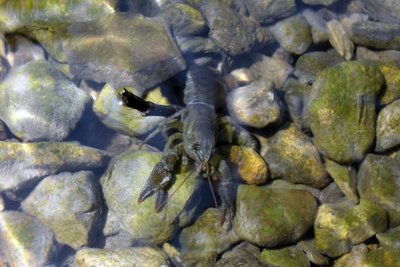The Cabane de Joubelle

Saint-Apollinaire Easy
Easy
The Cabane de Joubelle
2h
2,9km
+197m
-196m
Return trip
Embed this item to access it offline
From the Lac de St-Apollinaire, make your way through the forest to the forest cabin ("Cabane Forestière"). This walk through a designated Natura 2000 site abounds with wild species. You need to keep an ear and eye out if you want to spot its forest inhabitants. The numerous vantage points over the territory will complete this pleasant excursion.
Description
- From the car park, follow the right-hand shore of the lake and take the track running uphill to the left, next to the water fountain. After the hairpin bend, carry straight on and continue along the track as it rises.
- When you come to the electricity pylons, turn left.
- When you are on the forest road, head left and fork onto the track on the right heading towards the Aiguilles de Chabrières and the Cabane de Joubelle. The Forest Centre ("Maison Forestière") is a short distance further up. Sheltered from the sun, with picnic amenities.
- Departure : Lac de St Apollinaire, St Apollinaire
- Arrival : Lac de St Apollinaire, St Apollinaire
- Towns crossed : Saint-Apollinaire
5 points of interest

Pouillot de Bonneli - Mireille Coulon - PNE  Fauna
FaunaWestern Bonelli's warbler
The Western Bonelli's warbler is a small passerine in the family Sylviidae. Greyish green-brown on the upper side, its very white breast and belly are an identifying feature. It can be differentiated from similar species by its dark legs, its flight feathers and wing coverts edged with yellowish green and its yellowish rump. An insect lover, it is migratory and can be found in the Les Écrins massif and around Serre-Ponçon between April and August.
Chardonneret élégant - Jean-Philippe Telmon - PNE  Fauna
FaunaThe goldfinch
The goldfinch is a small passerine bird. It has a brown back, black wings with a conspicuous yellow wing bar, a red face and a black and white head. It is found in forests but also in rural farmland and gardens. They form into groups which can often be seen on bird feeders. Essentially it is a granivore, or seed eater, and is particularly fond of the fruits of the globe thistle, (chardon in French hence the bird's French name “chardonneret”). Its beak is designed to winkle out the seeds from behind the spikes. The young are fed on insects, however.
Sitelle torchepot - Mireille Coulon - PNE  Fauna
FaunaThe wood nuthatch
The wood nuthatch is a small resident bird the size of a tit. Its speciality is working its way down tree trunks upside down. It nests in cavities in trees, most of which are excavated by woodpeckers (green woodpecker, spotted woodpecker, black woodpecker). When the entrance to the hole is too big, it reduces the diameter to a suitable size using mud which forms a wall. The aim is to protect its nestling from predators. This special characteristic has earned it the French nickname torche-pot (a reference to edging the rim of a vessel).
Lac de St Apollinaire - Amélie Vallier  Lake
LakeThe Lac de Saint-Apollinaire
This small glacial lake nestles amidst larch forest at an altitude of 1,452 metres and its shores make for a pleasant walk. It forms a green backdrop and constitutes a fine vantage point looking over the valley. It lies at the end of a narrow road leading from the village of Saint-Apollinaire. The nearby campsite and the few tourist amenities in no way detract from the beauty and tranquillity of the site. There are two car parks, one on the lakeside, making the lake accessible to all and another further downhill on the road, offering a pleasant countryside walk. The lake is reserved for fly-fishing, and a no-kill policy is practised, that is to say, the fish must be returned live into the water. It is populated by chub and trout.
Écrevisse à Pied Blanc - Damien Combrisson - PNE  Fauna
FaunaWhite-clawed crayfish
This species is a bioindicator of its environment, that is to say, it signals the good ecological health of its living environment. It is greenish brown on its back and underside and, as its name suggests, its claws are white. It can grow up to 12 cm in length and can live between 8 and 10 years. Its outer shell has several small characteristic lateral spines. Its mouth is edged with a pair of lateral "teeth". It feeds on plants, small invertebrates, amphibians and dead fish. It can lay 40 to 200 eggs. The young hatch between May and July.
Forecast
Altimetric profile
Information desks
Tourist office Chorges
Grand rue, 05230 Chorges
October to may : Monday to Saturday, 9.00 - 12.30 & 13.30 - 17.00.
April, may, june & september : Monday to Saturday, 9.00 - 12.30 & 14.30 - 18.00
July and August : Monday to Saturday, 9:00 – 12.30 & 14.30 – 19.00 Sunday 9.30 – 12.30
Closed on Thursdays outside French holidays’ periods
Closed on French national holidays, except 14th of July and 15th of August
Transport
Public transport: www.pacamobilite.fr
Consider car-sharing: www.blablacar.fr
Access and parking
From the village of St-Apollinaire coming from Chorges, turn left at the sign for the Lac de St-Apollinaire D509T. Then, drive to the car park at the Lac de St-Apollinaire.
Parking :
Car park at the Lac de St-Apollinaire
Accessibility
Family
- Emergency number :
- 114
More information
Source

Serre-Ponçonhttps://www.serreponcon.com
Report a problem or an error
If you have found an error on this page or if you have noticed any problems during your hike, please report them to us here:

